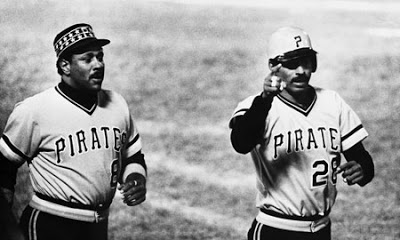|
As somebody who often took his children to work, I can relate to Adam Laroche, who “retired” from baseball the other day.
Laroche quit the Chicago White Sox after being told by his general manager to “dial it back” about bringing his 14-year-old son to workouts and the clubhouse every day during spring training. He has been getting support from current and former teammates, who insist baseball is a “family game.” It must be – Laroche’s father and brother have also played in the majors. Drake Laroche quite likely has great third-generation genes. It’s good to encourage people to enter the family business. I took all three of our kids on assignments with me. One of the proudest moments in my career was in 2000 during the Yankees’ playoff series in Seattle. While chatting with Bernie Williams, I looked around the clubhouse and saw our daughter, Laura, then a columnist in Seattle, chatting with her old friend, Tino Martinez, and I saw my son, David, then working for a web site, chatting with Paul O’Neill. (Our third child, Corinna, a lawyer, has also worked in and around journalism much of her career.) Still, it’s tricky, bringing children into a clubhouse. The Griffey family discovered that in 1983 when Ken Griffey Sr. brought his two sons to Yankee Stadium. Billy Martin, who had his mood swings, became angry with a small knot of players’ sons romping in the narrow hallways of the old Yankee Stadium and had a staff member tell the boys to vanish. Junior, who was around 13 at the time, never denied his grudge against the Yankees. His Seussian smile when he scored the winning run in the epic 1995 series with the Yankees undoubtedly came from sheer joy, not from old feuds, but still….During his free-agent days, he never entertained offers from the Yankees, even though Billy was long gone. Is baseball a family game? More than it used to be. I don’t recall sons visiting the cramped clubhouse in the old Stadium when Mickey Mantle was conducting replays of his other night games. Clubhouses were often more Rabelaisian than today. Much of that mercifully disappeared after female reporters made their long-deserved arrival and most ball players of normal I.Q. made the major discovery that one large well-placed towel could solve most privacy issues. Plus, the newer clubhouses in New York and elsewhere have inner sanctums where players can shower, and get stuff off their minds. But is it a good idea to have sons -- let’s say sons for the sake of discussion -- wandering around the clubhouse and field all the time during spring training? My feeling is that players do have the right to bond, talk baseball, hash things out, even cuss at each other. And I do mean cuss. In 1980, I brought my 10-year-old son to an exhibition in Bradenton, Fla., home of the champion “we-are-fam-a-lee” Pittsburgh Pirates. My friend Bill Robinson, after his rough Yankee days, was having hard-earned success in his later years. Mary Robinson invited us all over for dinner that night. But before that, Bill invited Dave into the clubhouse, after most of the players had showered and dressed. Dave had been in a clubhouse or two and knew about players. As we sat around Bill’s locker, there was a loud noise from the shower area. Two of the biggest stars – no names mentioned – emerged from the showers, still wet, wearing nothing but very large and shiny bling, not fighting but conducting a philosophical discussion, using words Dave had surely heard before but never in such imaginative pairings and repetition and volume. Bill was a family guy. In his measured voice he said, “Uh, David, maybe you better wait outside.” Times have changed. Clubhouses are larger, more accommodating to a family presence. But as my late friend Bill Robinson knew, sometimes it may also be good for children to wait outside.
Brian Savin
3/18/2016 12:48:19 pm
Very, very interesting column, George. I'd call it an Exhibit A in why sound bite headlines can never substitute for experienced journalism. It can even cut through a "cute kid" headline. Making us think and not just "emote" is like adult spinach....good for us!
Hansen Alexander
3/19/2016 06:50:30 pm
Great back ground stuff, George, and a pleasure to read. What strikes me as odd is that La Rouche has obviously been taking his boy inside the club house for a long time and the new prohibition sounds as if it came out of the blue.
George Vecsey
3/20/2016 01:45:11 pm
Guys, thanks. Couple of second thoughts:
Hansen Alexander
3/20/2016 02:19:17 pm
Yeah, George, but I would think "some space" would be the places that are now off limits to the press too, toilets, sauna, etc. Given the long tradition of letting kids in the clubhouse, a GM or other official should not have a blank check to decide what is off limits depending on his mood. That is just plain being mean. And such team officials should be fired, IMO.
George Vecsey
3/21/2016 09:00:29 am
Hansen, the GM will be fired, if he loses the team.
John McDermott
3/21/2016 07:42:18 am
Billy Martin was simply one of the worst people I've ever encountered in professional sports. He made Pete Rose look like the Pope.
George Vecsey
3/21/2016 09:03:01 am
John, you saw him up close in the Bay Area, I would guess.
Elliott Kolker
3/23/2016 10:08:52 am
Laroche Family Values: "Mendoza Line" Nobility
Elliott H Kolker
3/23/2016 11:06:06 pm
Originally posted with previous comment. It was cut off: Comments are closed.
|
Categories
All
|










